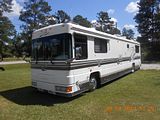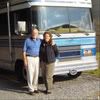Page 1 2
Go to...  | Start A New Topic  | Search  | Notify  | Tools  | Reply To This Topic  |  |
Captain Doom |
Nick Cagle, knowing that I was a field engineer with Shell Oil, and one of two Navy "Fuels and Lubricants Technical Officers", asked me to post some observations concerning lubricants. The first observation is: "Oil's cheaper than metal." Synthetic oils have one common trait: They're homogeneous, which means the characteristics can be accurately predicted, because there are no intruders. This makes them more predictable, and thus, more stable, when combined with a suitable additive package. I'll start with motor oil. In StaRV II's engine, I use only Shell Rotella T 15W40. The only other oils I'd consider are Mobil Delvac and Kendall Super D-III (both of which are superior to all others - IMHO). I'd not even give a passing glance to synthetic oil in a diesel, since depletion of the additive package will occur long before the base stock deteriorates. With Low-Sulfur Diesel (LSD), I changed oil every 3,000 miles. With ULSD, I'm going to 4,000. Sulfur is a major culprit in determining service life of motor oils (sulfur combined with water from condensation and combustion byproducts results in H2SO4 - sulfuric acid). Oddly enough, sulfur in a base stock can be beneficial in blending motor oil...go figure. Despite claims to the contrary, only Shell and Mobil are the leaders in diesel motor oil. For gaso engines, Shell, Mobil, and Chevron are the routine picks, (with the Mobil 1 Synthetic the first choice in my Lexus LS-400), along with Castrol and Kendall synthetics. I don't even use Quaker State for door hinges. Motor oils consist of a base stock, along with an additive package, which may be as much as 40% by volume. The tasks of a motor oil are to: Clean, cool, lubricate, seal, and protect. Cleaning is accomplished through the detergent-dispersant additive additives such as zinc diorgano-dithiophosphate do dual duty - kill contaminants and provide cam anti-scuff lube; cooling is accomplished by way of engine design and oil formulation. Lubrication is self-descriptive, but the additives must allow the oil to do what it has to, by diverting or neutralizing contaminants. Sealing is basically a function of viscosity, and this means a multigrade oil must have shear stability (more below). Protection is provided by the additive package in two ways. First, the additives must inhibit contaminants from attacking angine parts, and secondly, the package must protect the oil itself from adverse effects. Shear stability: Multigrade oils' makeup is widely misunderstood. The common misconception is that multigrades get thicker as the temperature rises. Not so. A 15W oil has its viscosity measured at 0°F. A 40 oil has its viscosity measured at a higher temp; all oils thin out as the temp rises. A 15W oil measured at that temp will be much thinner. So how are multigrade oils made? a 15W base stock has added to it viscosity index improvers (VSI). The Viscosity Index (VI) is a measure of how much an oil thins out as temp increases. No virgin base stock has a decent VI. The trick is to add molecules. Viscosity is a function of molecule size; bigger molecules result in higher (thicker) viscosity. Add big molecules, you get thicker oil. But when you do, the oil no longer acts thin at the 0°F temp. The solution is to add molecules that are big, but coiled up at lower temps (acting like little molecules), but strech out (acting like larger molecules) at higher temps. One of the first such molecules used was polyisobutylene (as in STP). But it had a drawback. The molecules of polyisobutylene did what was wanted, but were so big, they would be mechanically broken (sheared) in the ring-cylinder interface. In itself this would only result in a thinning of the oil, but sadly, the resulting sheared pieces manifested themselves in ringbelt and valve deposits, both of which were hard, gritty substances. Times have changed, and mre resilient molecules no accomplish the task, with sturdy shear stability. Much has been made of the issue of "Pennsylvania-grade" lubricants. Those stocks are paraffinic, and "competed" with napthenic stocks from other oil fields. Paraffinic stocks are natively very stable, but when they do break down, the result is hard, gritty deposits. Conversely, the napthenic stocks, when breaking down, produce gummy residue, like varnish. The best contemporary motor oils use a paraffinic base stock with additives to prevent breakdown. Gear Oil: Kendall has for decades been the leader in differential lube, despite the resources available to the major oil companies. However, I use Amzoil in StaRV II's rear end, as it's pretty good. I don't subscribe to that brand's motor oil hype, however. Gear oil comes in three flavors (basically). GL-4 is for straight-cut gears; GL-5 is generally formulated for hypoid gearsets and locking differentials. Hypoid gears require more additives. In short, what Barthers will encounter will be quite happy with GL-4. For chassis lube, I use Mobil 1 "synthetic grease". The quotes are because Mobil 1 has a synthetic base stock with a common lithium thickener; this allows some separation, which is preferred in wheel bearings and chassis lube points. A Lesson: Grease is not just a thick oil. NGLI (National Gear Lube Institute) Grade 2 (the most common grade), as are all greases, composed of an oil base stock (commonly around a 10W viscosity oil) to which thickeners are added. The most widely-used thickener is a lithium-12 hydroxy stearate. Basically, this is similar to hand soap, the difference being is that's sodium based, and hand soap is (obviously) water-soluble. Soaps based on sodium's cousin lithium are not. For applications where I don't want separation, I use Super Lube Grease and Super Lube Spray, because both the base stock and the thickener are synthesized. Rusty '94 28' Breakaway: MilSpec AMG 6.5L TD 230HP Nelson and Chester, not-spoiled Golden Retrievers Sometimes I think we're alone in the universe, and sometimes I think we're not. In either case the idea is quite staggering. - Arthur C. Clarke It was a woman who drove me to drink, and I've been searching thirty years to find her and thank her - W. C. Fields | ||
|
 |
Thanks for the lesson Rusty. Nick | |||
|
FKA: noble97monarch 3/12 3/12 |
Rusty, Great article! I wonder if you could also expand on the difference between motorcycle oil versus auto? I ran a bike shop years ago and recall bike oils have polymers to keep the gears from crushing the oil, or something to that line of reason. The difference had to do with motorcycles using oil commonly throughout the gear box and engine, if I recall. I know this isn't a bike forum, but many of us are gear heads and have all the toys. More importantly, we have you to tap for free advice! Corey  Formerly: 1997 Barth Monarch Now: 2000 BlueBird Wanderlodge 43' LXi Millennium Edition DD Series 60 500HP 3 stage Jake, Overbuilt bike lift with R1200GS BMW, followed by 2011 Jeep Wrangler Unlimited, “I haven’t been everywhere, but it’s on my list.” | |||
|
Captain Doom |
Motorcycle oils have migrated towards automotive motor oils. Where the motorcycle oil lubricated an integral gearbox, extreme pressure (EP) additives were used to maintain the integrity of the film. External gearboxes use plain gear oils, as do differentials. If the gears are helical cut (hypoid), the gear faces make sliding contact, and a 'heavy-duty" (HD) additive is added. Motorcycle oil, in air-cooled engines, is also subjected to higher temperature variations. translation of some abbreviations and acronyms are in order: SAE: Society of Automotive Engineers; translated the technical expression of oil viscosity into a form understandable by vehicle owners. Oils were divided into winter and summer grades; the former, with viscosity measured around -35°C for 0W, -5C for 25W, carry the W tag. Summer grades are measured at 100°C. A multigrade oil (i.e., 15W40, has a viscosity index improver (VII) added to resist thinning, and so falls on the scale at low and high temperatures. API: American Petroleum Institute; established the performance standards for motor oil. Originally, the standards were for detergent and non-detergent. As engine design progressed, motor oil had to be more robust, and additives became essential. Around 1969, the current classification system was implemented, "S" for Service Class (gasoline engines), "C" for Commercial (diesels). Caterpillar: Series 3 oils were developed specifically for Cat off-road engines, which typically burned high-sulfur #4 fuels (as did diesel locomotives). Shell Oil developed Rimula in cooperation with Cat. NGLI: National Gear Lube Institute; classified gear oils and greases according to various criteria. A #2 grade (thickness) grease is actually NGLI #2. They also classified gear oils and greases according to peformance; those bear HD, EP, or no designations. GL-4 gear lubes are typicall EP; GL-5s are HD, and are used in locking differentials (posi-traction) ATF: Automatic Transmission Fluid; the auto manufacturers went on diverging paths. While the ATFs looked the same, Ford (then M2C33, now Mercon specs) used a tight slip-stick differential. This is a semi-technical way of saying that as the sliding surfaces approach lockup, the friction increases, causing a firm shift. Chrysler and GM (Dexron)used a loose slip-stick differential. As surfaces approached lockup, the friction decreased, making shifts smoother. Detergent-Dispersents: Generally, two types, metallic ash (such as barium or calcium salts). Very finely ground ash is added to the oil. These fines encounter particles of acid and chemically neutralize them. Ashless detergents are liquid, and have a negative valence, and so are chemically attracted to acid (positive valence) and metal engine parts (also positive valence). The ashless detergents protect by coating the acid particles. In the past, combinations of ash-type and ashless detergents were used, with the ashless reacting more quickly to isolate the acid until a metallic ash particle encounter it, where the acid was neutralized and the ashless particle was freed to work again. Rusty '94 28' Breakaway: MilSpec AMG 6.5L TD 230HP Nelson and Chester, not-spoiled Golden Retrievers Sometimes I think we're alone in the universe, and sometimes I think we're not. In either case the idea is quite staggering. - Arthur C. Clarke It was a woman who drove me to drink, and I've been searching thirty years to find her and thank her - W. C. Fields | |||
|
Great article. I have used shell for years. Fist in an airplane and later in a 2 stroke detroit when I converted a bus. I know even to this day DD still recommends straight wait oils for the 2 strokes due to the shearing action. I assume this is over the intake ports on the cylinder. It is my understanding that 15W40 will quickly become only 15W. I use 15W40 Rotella in the Barth because I can get it anywhere. When I changed transmissions, all the Allison folks really pushed me to use transynd. This is a synthetic produced by Castrol. Use of Transynd means you will probably never have to touch the tranny again for 75K miles at which time you give it a new drink. Anyway thanks for the lesson. '92 Barth Breakaway - 30' 5.9 Cummins (6B) 300+ HP 2000 Allison Front entrance | ||||
|
Captain Doom |
Around 1970-71, Detroit Diesel (GM) uprated the 6-71 to 318HP by installing larger injectors. There arose a lot of cases of failures due to ringbelt and valve deposits. The higher cylinder temps of the two-stroke was a contributing factor, and dumping more fuel into the engine didn't help. DD then specified oils with no more than 1% metallic ash. Tests at Shell didn't support the conclusion, but DD engines used straight Rotella - even if supercharged; Rotella T had a metallic ash content of about 1.5%. Mack had its own specs (EO-x) for the Maxidyne. The latest spec is CG-4; Rotella T is qualified. There's a lucid and accurate description of synthetics and additives here. BTW, Shell names its oils for clams...its logo is Pectin Maximus. Rotella, Rimula, Tornus, Darina, are all clams...
VIIs have become steadily better since the first, polyisobutylene (the main constituent of STP), was introduced. VIIs consist of molecules that are coiled at low temps, acting like small molecules and uncoil at high temps, acting like large molecules. Small molecules=thin, large molecules=thick, so a motor oil with it thins out less as the temp increases. A 15W40 oil is a 15W oil to which VIIs have been added. Polyisobutylene suffered one serious drawback: The molecules were so large and fragile when hot they could be mechanically sheared against the cylinder walls. The resulting fragments showed up as gritty deposits, primarily in the ringbelt. Today, you'll hear the term "shear-stable"; this claims the VII used maintains integrity throughout the oil's service life. This is prettty much true, as VIIs have become much more durable, so Mobil or Shell 15W40 maintains that 40 vis. Rusty '94 28' Breakaway: MilSpec AMG 6.5L TD 230HP Nelson and Chester, not-spoiled Golden Retrievers Sometimes I think we're alone in the universe, and sometimes I think we're not. In either case the idea is quite staggering. - Arthur C. Clarke It was a woman who drove me to drink, and I've been searching thirty years to find her and thank her - W. C. Fields | |||
|
| First Month Member |
One important consideration with motorcycle oil is where the clutch is. I have bikes with dry clutches, wet clutches that share oil with the engine and trans, just the engine, just the trans and clutches that have their own oil. At least one manufacturer reccomends ATF for the clutch and primary chain oil. The wrong oil on your clutch can be no fun. Anybody remember Hudsonite clutch oil? Smelled like harness oil. My two-strokes still like Blendzall. We recently spent a weekend in our Barth at the annual Blendzall cult gathering and inhalation intoxication symposium at Willow Springs. . 84 30T PeeThirty-Something, 502 powered | |||
|
Glassnose Aficionado |
Without going into where this came from, a friend says "My family has been running every tractor and truck on the farm on Rotella T for years. If it's good enough for those diesels it has to be the best oil for any engine." I've seen TV shows that explained the difference, but I can't explain it. How bout it Rusty? Right or wrong? 79 Barth Classic | |||
|
Captain Doom |
The synthetics perform better in gaso engines, as service life is less dependent on depletion of the additive package than in diesel engines. Shell's standard oil for naturally-aspirated engines was Rotella. The "T" in Rotella T is for "turbocharged". Rotella T had a stronger additive package that was more than just a greater dollop of the Rotella package; we marketed it as a "low-ash Series 3" because it tested and performed at that level. Because it met Mil-L-2104C/D (dual-fuel) and -46152 (extra-severe duty), it was also API approved for CC, CD, SC, and SD. Cat still used Rimula in truck engines; it was an extremely burly blend. We rebranded it as "metal-coating oil" due to its adhesion and corrosion-inhibiting properties. Spicer approved it for its transmissions (50 weight). BTW, as far as pure lubricating qualities go, castor oil is the standard... Rusty '94 28' Breakaway: MilSpec AMG 6.5L TD 230HP Nelson and Chester, not-spoiled Golden Retrievers Sometimes I think we're alone in the universe, and sometimes I think we're not. In either case the idea is quite staggering. - Arthur C. Clarke It was a woman who drove me to drink, and I've been searching thirty years to find her and thank her - W. C. Fields | |||
|
| First Month Member |
It is also the standard if you like the smell of extrnally-lubricated hairpin springs, hot sand-cast magnesium, methanol, and hot brakes. My wife has gone so far as to suggest a pipe tobacco with a little added. I am not sure she was hinting at a regularity problem or getting carried away with the spirit of the moment. As an interesting sidelight, pilots of WWI planes powered by the Gnome et Rhône Monosoupape were very regular. Right after every flight, in fact. Rotella T keeps getting mentioned here. I have noticed that it is very very popular in high performance circles, motorcycles included. It keeps getting high marks from so many. Rusty, I notice you prefer Mobil 1 for your gasser. Would you discuss Mobil 1 vs Rotella T synthetic? Do you have different preferences for roller lifters and flat lifters? re: zinc and the newer oil rating standards. I wonder if whale oil is still the standard for ATF. Has the jojoba bean done as well, now that whales are endangered? I have a clock restorer friend, and he gets whale oil from Russia. . 84 30T PeeThirty-Something, 502 powered | |||
|
Captain Doom |
I use Mobil 1 in my gasser because that's what the shop carries, and because it's formulated for gaso engines (meets API SL, SJ, and SH). Rotella T Synthetic does also, but meets the diesel classes CF-4 through CI-4 Plus (above in the thread I said "CG-4" is the latest, but that's a typo - CI-4+ is). The robust additive package of Rotella T Synthetic is excellent for diesels but overkill in a car; Mobil 1 is excellent. IMHO, Rotella T Synthetic is, at the moment, overkill in diesels; the additive package would be depleted before the base stock deteriorates. Now, since a major culprit in depleting additives is sulfur (sulfuric acid), transition to LSD and now USLD may allow oil change intervals to be extended. This would affect Cummins and Cat engines more than my AMG 6'5L, because of the much greater oil capacity. Nevertheless, oil's cheaper than metal (for now, at least Rotella T gets high marks because the VII is shear stable, the additive package is Series 3 qualified (and that ain't easy), and the base stock is very, very good. Shell formulates all its products, not to to produce stellar specs in some areas, but rather to eliminate shortcomings. The mineral oil based Rotella T has zinc (diorgano) dithiophosphate to prevent cam wear; I don't know about the synthetic, but it probably does, too. Roller lifters are generally unnecessary (cam wear is rare anymore) unless extreme high-lift cams are installed, or unusually high-compression valve springs are present, typical in very high speed engines. I see where now DD has approved Rotella T for use in -53, -71, and -92 series engines. Apparently, they figured out the engines, not the oil, caused the issues. BTW, I had a customer and friend who owned a DD shop (truck and marine) in Tampa, where my office was located. He called me to tell me to stop by, he had something to show me. This was during the days of the 6-71/318HP debacle, and what he had was a huge poster that advertised the engine as "The Cool One". Great I thought, they've come around, so I asked Don, "What changes did they make - water pump, radiator, recast cooling passages, what?" "You're lookin' at it." I told him, from the pictured engine, I couldn't see anything different. "The poster. That's what they changed, and that's all..." Rusty '94 28' Breakaway: MilSpec AMG 6.5L TD 230HP Nelson and Chester, not-spoiled Golden Retrievers Sometimes I think we're alone in the universe, and sometimes I think we're not. In either case the idea is quite staggering. - Arthur C. Clarke It was a woman who drove me to drink, and I've been searching thirty years to find her and thank her - W. C. Fields | |||
|
| First Month Member |
I am on a slow connection right now, so can't access much, but I have been reading about new spec low zinc oil being bad for flat lifters, particularly when new. I have even seen zinc additives sold to owners of flat tappet old bikes and cars.
Great story. I always am suspicious of any company that spends more on marketing than research. Too many of 'em out there. I always remember the Packard slogan, "Ask the Man who Owns One". That has gotta be the ultimate non-marketing marketing. . 84 30T PeeThirty-Something, 502 powered | |||
|
 6/12 6/12Formally known as "Humbojb"  |
Rusty, there's a line of lubricants, which I'm sure you've looked at, called "Red Line". They are very expensive synthetics. What's you're opinion of them? Also, someone once told me that Amsoil didn't actually make their own oils, that they were made by other refineries and you never knew which one or the actual specs they were made to. They went on further to say that the Amsoil thing was essentially a multi-level marketing gimic?? Thanks, I continue to be amazed at the quality of expertise shown on this web site on a variety of subjects. Jim
| ||||||||||||
|
Captain Doom |
Amatuzio tends to sell himself as much as the products. The Amsoil gear oils ARE excellent, but frankly, gear oil can be formulated by just about anyone, although Kendall does it better. It's doubtful Amsoil makes its own base stocks, considering the investment required. In fact, the jet turbine synthetics were made by Stauffer Labs (not Stauffer Chemical) for Shell when I sold them in the '60s and '70s. Synthetic base stocks are synthetic base stocks - since they're homgeneous, there's no mysteries as there are with mineral oils' constituents. Motor oils are, however, among the most difficult lubes to formulate. The additive package, not the base stock is the key. Amatuzio's products may be accetable, but I have no doubt that Shell and Mobil's are better. I mean, how could a company go wrong if its lead motor oil chemist in the '60s through '80s was named Charlie Brown? Rusty '94 28' Breakaway: MilSpec AMG 6.5L TD 230HP Nelson and Chester, not-spoiled Golden Retrievers Sometimes I think we're alone in the universe, and sometimes I think we're not. In either case the idea is quite staggering. - Arthur C. Clarke It was a woman who drove me to drink, and I've been searching thirty years to find her and thank her - W. C. Fields | |||
|
 6/12 6/12Formally known as "Humbojb"  |
I've used Mobil One and Amsoil forever, but recently switched to Red Line. At $9.49 a quart, what do you think makes it better than Mobil One or Amsoil? I still have Amsoil in everything in the Barth, but at the recommendation of a Volvo mechanic am trying the Redline in the motor, transmission and differential of my '82 Volvo. Used 10W40 in the engine, Red Line MT90 in the 4-speed+overdrive, and 75W90 in the diff. Would value your thoughts. Jim
| ||||||||||||
|
| Powered by Social Strata | Page 1 2 |
| Please Wait. Your request is being processed... |
|
This website is dedicated to the Barth Custom Coach, their owners and those who admire this American made, quality crafted, motor coach.
We are committed to the history, preservation and restoration of the Barth Custom Coach.
We are committed to the history, preservation and restoration of the Barth Custom Coach.



